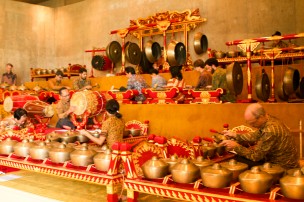
Many students and parents found a quieter alternative to the Homecoming football game on Saturday, Oct. 20. As the music resonated through the World Music Hall, parents and students eagerly entered to participate in a Gamelan Workshop hosted by the Center for the Arts (CFA).
Gamelan, a traditional Indonesian musical composite, employs a variety of instruments with a focus on metallophones, xylophones, drums, and bamboo flutes. Most of the instruments are bronze casts that include hanging gongs, racked gongs, and other mallet instruments. As “gamelan” literally translates to ensemble, the term usually refers to the set of instruments and the music they create as a whole.
The group performed at the beginning of the workshop, producing a polyphonic symphony of layered instrumental music. University Professor of Music Sumarsam then gave the audience a brief overview of the importance of the gamelan. He started off by asking the audience if anyone had any previous exposure to this type of music, and about half the people responded with a raised hand.
Sumarsam informed the audience that the gamelan is usually played during receptions, celebrations, and independence days. The piece that was played to welcome the audience emerged sometime around the 18th or 19th century. Sumarsam explained that the gamelan is frequently used during arrival of guests during special occasions.
Melodic patterns created continuity throughout the gamelan piece, while beautiful embellishments added subtle variety to the repetition. The symphony ended with a loud gong, in marking the finale.
Instead of a conductor, the strokes of the drums dictate the rhythm of the music. The top section of the orchestra preluded the gong that ended the piece. The middle row – deemed the “skeleton of the melody” by Sumarsam – included metallophones. The bottom row consisted of instruments that elaborated on said skeleton.
Sumarsam then opened the floor up to a Q&A, during which eager parents learned about the names of the instruments and asked whether or not the piece was improvised. According to Sumarsam, the embellishments of the patterns are improvised, but the overall piece is not. Additionally, sheet music is used only for learning purposes, but not normally during performances.
After the question section was another demo, after which Sumarsam talked about the addition of Japanese puppets to the music. He brought a few puppets with him and spoke about how to perform a show along with the music. He showed how he maneuvers the Japanese puppets to illustrate different kinds of stories. In this way, the show not only included gamelan music, but also displayed the art that revolves around it.
Sumarsam then asked for volunteers, who quickly and enthusiastically learned the basics of gamelan. The volunteers were mostly parents, but some students and their siblings were eager to learn how to play the instruments as well.
Coming up in April is a Music and Public Life symposium that showcases the art of gamelan and the students who are a part of Sumarsam’s class.


Leave a Reply